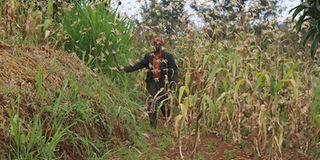UN agency warns of more locust swarms

A farmer at Karundu village in Nyeri tries to scare away desert locusts on February 19, 2020. PHOTO | FILE | NATION MEDIA GROUP
What you need to know:
- The insects threaten the food security of pastoralists in Samburu, with more than 85,000 acres of vegetation cover at risk.
The first generation of desert locusts in Kenya has matured and is ready to breed, according to a United Nations agency.
Desert locusts normally mature and start laying eggs from two to four months. This means that the first generation of locusts bred in the counties of Samburu, Isiolo, Wajir Mandera and Marsabit could begin mass breeding.
The Food and Agriculture Organisation (Fao) - in an update dated April 28 - warned that the current situation in East Africa remains extremely alarming as more swarms form and mature in Ethiopia and northern and central Kenya.
"A new generation of breeding is underway in Kenya, where more eggs will hatch and form hopper bands during May, followed by new swarms in late June and July, which concluded with the start of harvesting," Fao said.
Samburu Special Programmes chief officer Daniel Lesaigor said that most swarms in Samburu have already reached maturity and mass breeding could start if they are not destroyed.
Mr Lesaigor said disaster management teams are on high alert and are monitoring the situation even as heavy rains threaten to halt aerial spraying.
"It is challenging, but we are trying our best to contain the spread. We are spraying with the guidance of the meteorological department to avoid a situation where we spray and rain wash away the chemicals," he said.
Heavy rainfall continues to pound various counties affected by the locusts, including Samburu, Isiolo and Marsabit.
Experts say rainfall and warmer temperatures provide favourable conditions for breeding.
It is estimated that more than 30,000 people in Samburu have been affected. The insects threaten the food security of pastoralists across the county, with more than 85,000 acres of vegetation cover at risk.





